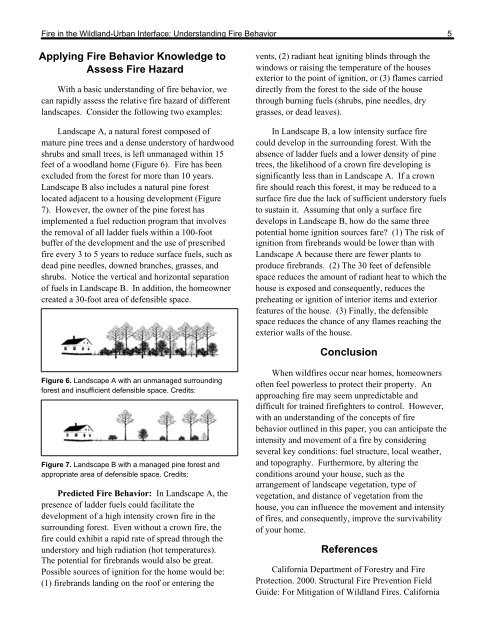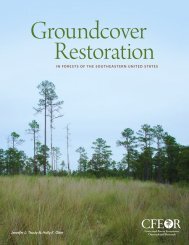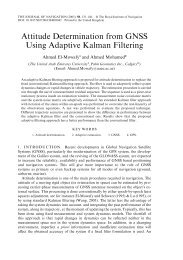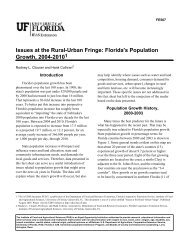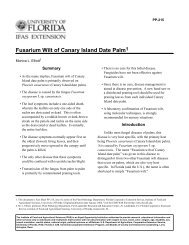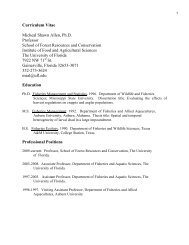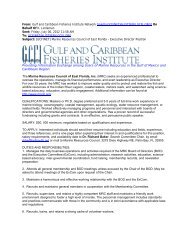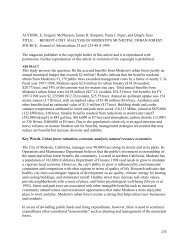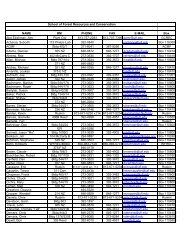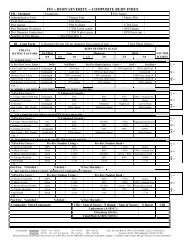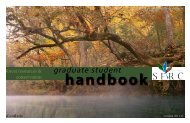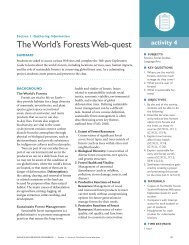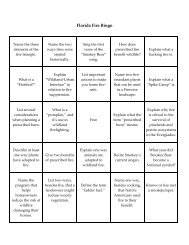Fire in the Wildland-Urban Interface: Understanding Fire Behavior
Fire in the Wildland-Urban Interface: Understanding Fire Behavior
Fire in the Wildland-Urban Interface: Understanding Fire Behavior
You also want an ePaper? Increase the reach of your titles
YUMPU automatically turns print PDFs into web optimized ePapers that Google loves.
<strong>Fire</strong> <strong>in</strong> <strong>the</strong> <strong>Wildland</strong>-<strong>Urban</strong> <strong>Interface</strong>: Understand<strong>in</strong>g <strong>Fire</strong> <strong>Behavior</strong> 5Apply<strong>in</strong>g <strong>Fire</strong> <strong>Behavior</strong> Knowledge toAssess <strong>Fire</strong> HazardWith a basic understand<strong>in</strong>g of fire behavior, wecan rapidly assess <strong>the</strong> relative fire hazard of differentlandscapes. Consider <strong>the</strong> follow<strong>in</strong>g two examples:Landscape A, a natural forest composed ofmature p<strong>in</strong>e trees and a dense understory of hardwoodshrubs and small trees, is left unmanaged with<strong>in</strong> 15feet of a woodland home (Figure 6). <strong>Fire</strong> has beenexcluded from <strong>the</strong> forest for more than 10 years.Landscape B also <strong>in</strong>cludes a natural p<strong>in</strong>e forestlocated adjacent to a hous<strong>in</strong>g development (Figure7). However, <strong>the</strong> owner of <strong>the</strong> p<strong>in</strong>e forest hasimplemented a fuel reduction program that <strong>in</strong>volves<strong>the</strong> removal of all ladder fuels with<strong>in</strong> a 100-footbuffer of <strong>the</strong> development and <strong>the</strong> use of prescribedfire every 3 to 5 years to reduce surface fuels, such asdead p<strong>in</strong>e needles, downed branches, grasses, andshrubs. Notice <strong>the</strong> vertical and horizontal separationof fuels <strong>in</strong> Landscape B. In addition, <strong>the</strong> homeownercreated a 30-foot area of defensible space.vents, (2) radiant heat ignit<strong>in</strong>g bl<strong>in</strong>ds through <strong>the</strong>w<strong>in</strong>dows or rais<strong>in</strong>g <strong>the</strong> temperature of <strong>the</strong> housesexterior to <strong>the</strong> po<strong>in</strong>t of ignition, or (3) flames carrieddirectly from <strong>the</strong> forest to <strong>the</strong> side of <strong>the</strong> housethrough burn<strong>in</strong>g fuels (shrubs, p<strong>in</strong>e needles, drygrasses, or dead leaves).In Landscape B, a low <strong>in</strong>tensity surface firecould develop <strong>in</strong> <strong>the</strong> surround<strong>in</strong>g forest. With <strong>the</strong>absence of ladder fuels and a lower density of p<strong>in</strong>etrees, <strong>the</strong> likelihood of a crown fire develop<strong>in</strong>g issignificantly less than <strong>in</strong> Landscape A. If a crownfire should reach this forest, it may be reduced to asurface fire due <strong>the</strong> lack of sufficient understory fuelsto susta<strong>in</strong> it. Assum<strong>in</strong>g that only a surface firedevelops <strong>in</strong> Landscape B, how do <strong>the</strong> same threepotential home ignition sources fare? (1) The risk ofignition from firebrands would be lower than withLandscape A because <strong>the</strong>re are fewer plants toproduce firebrands. (2) The 30 feet of defensiblespace reduces <strong>the</strong> amount of radiant heat to which <strong>the</strong>house is exposed and consequently, reduces <strong>the</strong>preheat<strong>in</strong>g or ignition of <strong>in</strong>terior items and exteriorfeatures of <strong>the</strong> house. (3) F<strong>in</strong>ally, <strong>the</strong> defensiblespace reduces <strong>the</strong> chance of any flames reach<strong>in</strong>g <strong>the</strong>exterior walls of <strong>the</strong> house.ConclusionFigure 6. Landscape A with an unmanaged surround<strong>in</strong>gforest and <strong>in</strong>sufficient defensible space. Credits:Figure 7. Landscape B with a managed p<strong>in</strong>e forest andappropriate area of defensible space. Credits:Predicted <strong>Fire</strong> <strong>Behavior</strong>: In Landscape A, <strong>the</strong>presence of ladder fuels could facilitate <strong>the</strong>development of a high <strong>in</strong>tensity crown fire <strong>in</strong> <strong>the</strong>surround<strong>in</strong>g forest. Even without a crown fire, <strong>the</strong>fire could exhibit a rapid rate of spread through <strong>the</strong>understory and high radiation (hot temperatures).The potential for firebrands would also be great.Possible sources of ignition for <strong>the</strong> home would be:(1) firebrands land<strong>in</strong>g on <strong>the</strong> roof or enter<strong>in</strong>g <strong>the</strong>When wildfires occur near homes, homeownersoften feel powerless to protect <strong>the</strong>ir property. Anapproach<strong>in</strong>g fire may seem unpredictable anddifficult for tra<strong>in</strong>ed firefighters to control. However,with an understand<strong>in</strong>g of <strong>the</strong> concepts of firebehavior outl<strong>in</strong>ed <strong>in</strong> this paper, you can anticipate <strong>the</strong><strong>in</strong>tensity and movement of a fire by consider<strong>in</strong>gseveral key conditions: fuel structure, local wea<strong>the</strong>r,and topography. Fur<strong>the</strong>rmore, by alter<strong>in</strong>g <strong>the</strong>conditions around your house, such as <strong>the</strong>arrangement of landscape vegetation, type ofvegetation, and distance of vegetation from <strong>the</strong>house, you can <strong>in</strong>fluence <strong>the</strong> movement and <strong>in</strong>tensityof fires, and consequently, improve <strong>the</strong> survivabilityof your home.ReferencesCalifornia Department of Forestry and <strong>Fire</strong>Protection. 2000. Structural <strong>Fire</strong> Prevention FieldGuide: For Mitigation of <strong>Wildland</strong> <strong>Fire</strong>s. California


